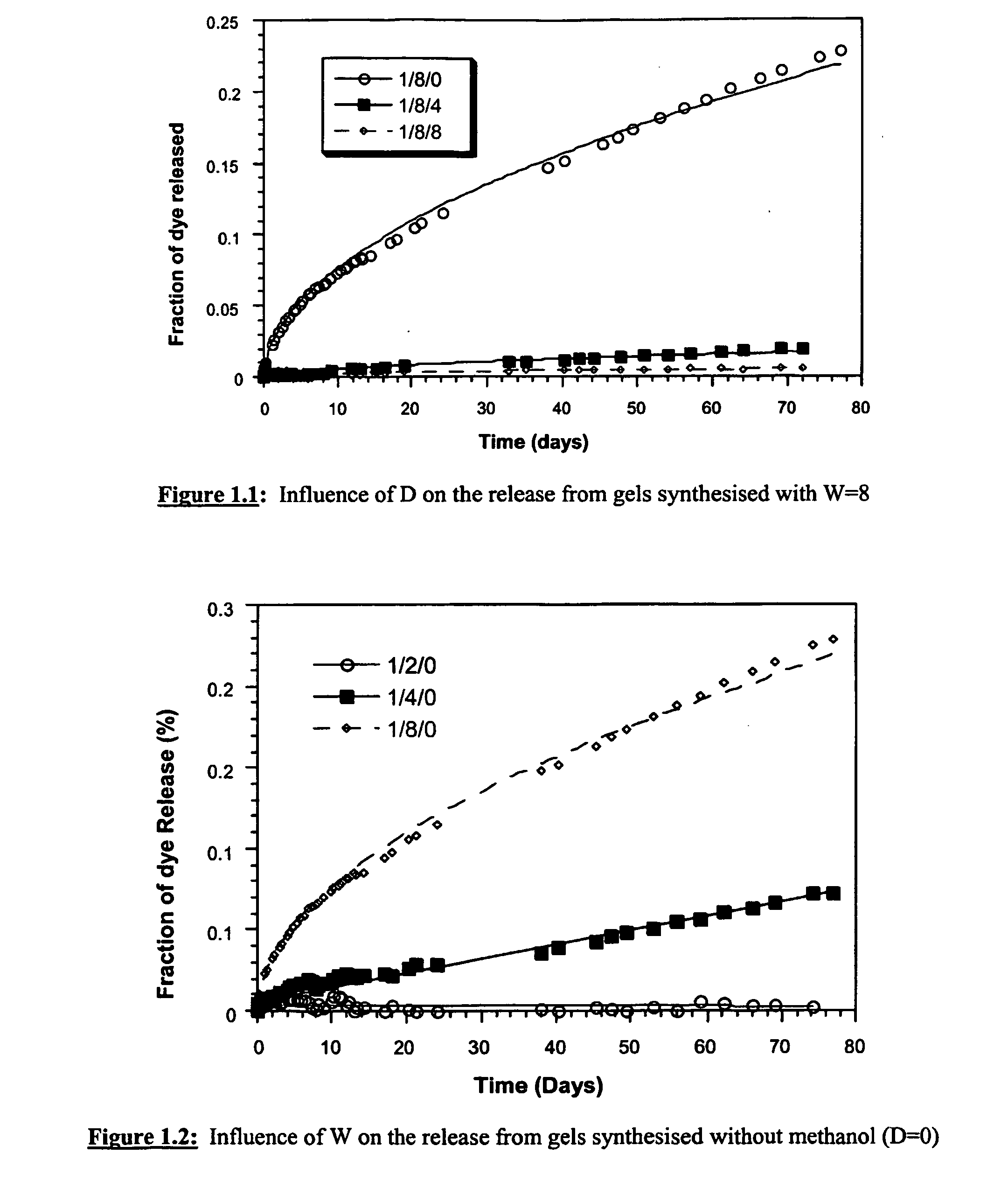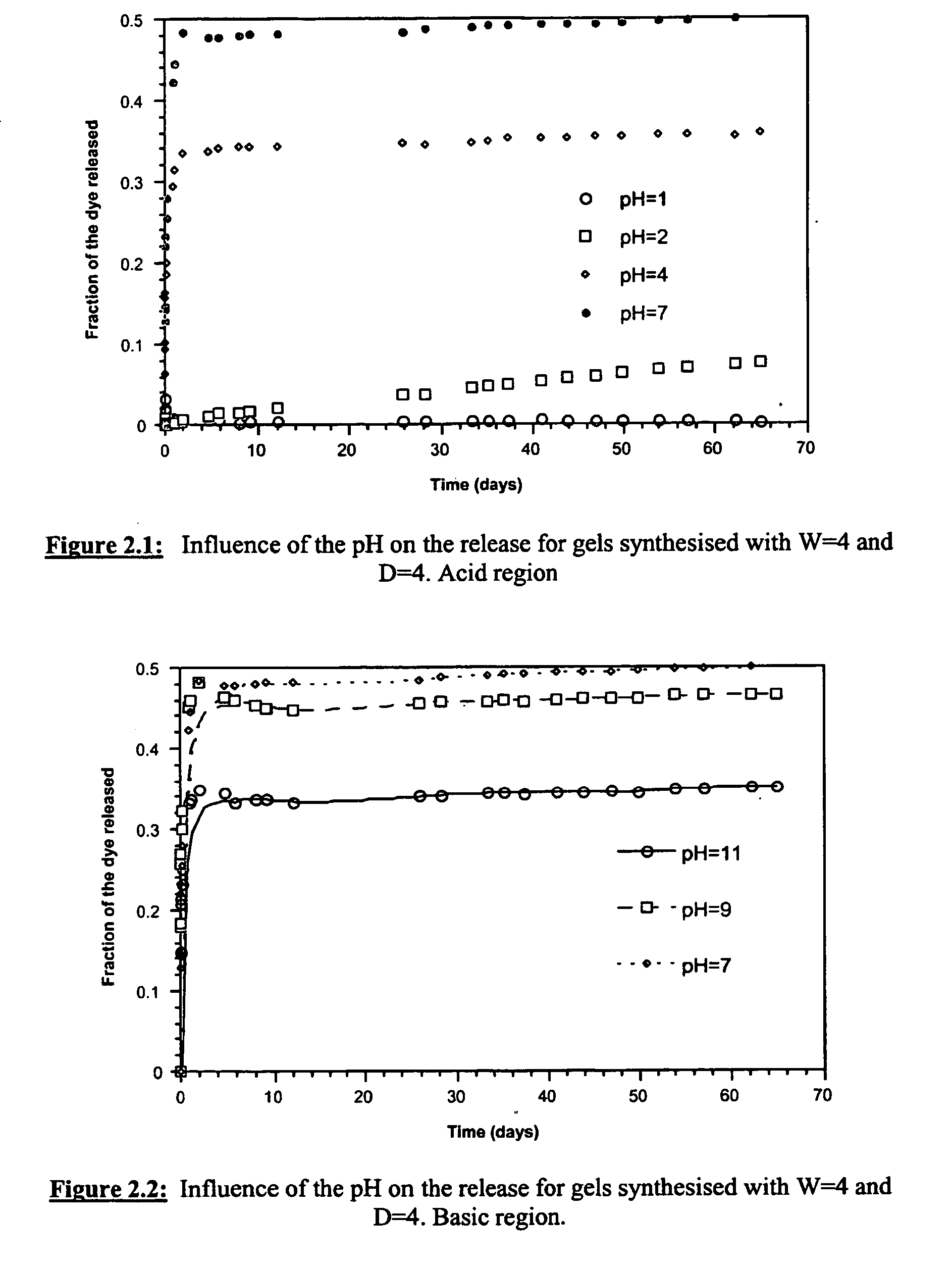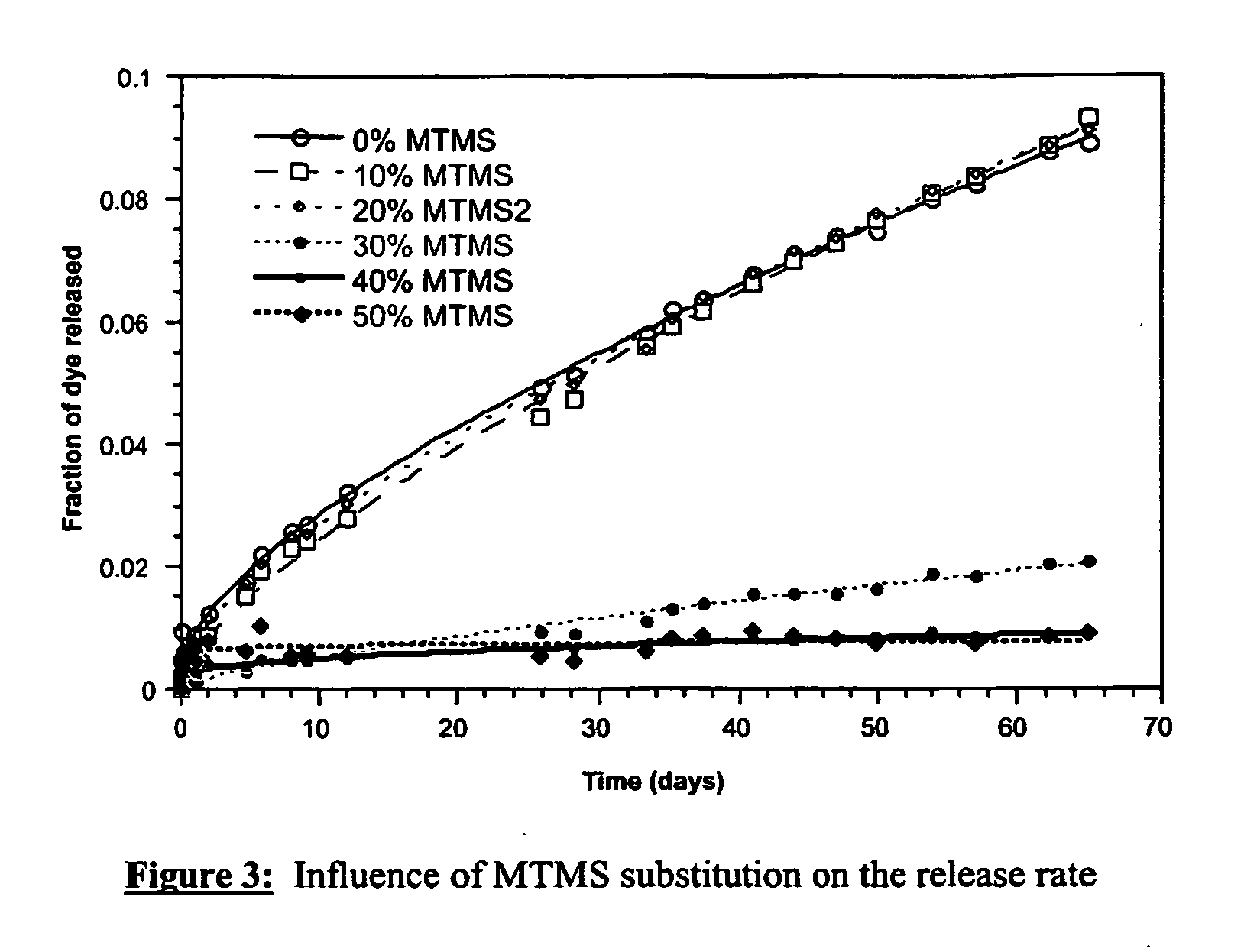Controlled release ceramic particles, compositions thereof, processes of preparation and methods of use
- Summary
- Abstract
- Description
- Claims
- Application Information
AI Technical Summary
Benefits of technology
Problems solved by technology
Method used
Image
Examples
example 1
Influence of the Methanol / TMOS and H2O / TMOS Molar Ratios on the Release Rate of Orange II
[0295] A solution of dye was produced by dissolving 0.25 g of 4-(2-hydroxy-1-napthylazo) benzene sulfonic acid, sodium salt (i.e. Orange II, Aldrich) in 25 ml of a 0.1M nitric acid solution and diluting to 250 ml with demineralised water. The final pH of the dye solution was 2.
[0296] Gels were synthesised by combining tetramethylorthosilicate (TMOS), methanol (MeOH), and the dye solution. The influence of H2O / TMOS ratio (W) and MeOH / TMOS ratio (D) on the dye release rate was studied by using the compositions listed in Table 1.
TABLE 1Compositions of gels synthesised with different W and D.D = 0D = 4D = 8W = 2TMOS (8.10 ml,TMOS (5.00 ml,TMOS (3.00 ml,54.4 mmol)33.6 mmol)20.2 mmol)H2O1 (1.96 ml,H2O (1.21 ml,H2O (0.73 ml,109 mmol)67.2 mmol)40.3 mmol)MeOH (5.44 ml,MeOH (6.54 ml,134 mmol)161 mmol)W = 4TMOS (8.10 ml,TMOS (4.00 ml,TMOS (3.00 ml,54.4 mmol)26.9 mmol)20.2 mmol)H2O (3.92 ml,H2O (1.94 ml...
example 2
Influence of the pH on the Release Rate of Orange II
[0301] To study the influence of pH, gels were prepared by adjusting the pH of the dye solutions to 1,2, 4, 7, 9 or 11.
[0302] The different dye solutions were produced by dissolving 0.10 g of Orange II dye in 100 ml of nitric acid (0.1 M) or aqueous ammonia (0.1M) and further adjusting, by titration, the pH to the desired value.
[0303] The gels were synthesised by mixing 5.51 ml of TMOS (37 mmol), 2.67 ml of dye solution at the appropriate pH (148 mmol of water) and 6 ml of methanol (148 mmol). The samples were then aged and dried according to the procedure described in example 1. The corresponding release curves are presented in FIG. 2.
[0304] For gel synthesised using acid as a catalyst (FIG. 2.1), the release rate was found to increase with increasing pH. In contrast, for the gel synthesised using base as a catalyst, the release was found to decrease with increasing pH. The maximum release rate was observed at pH=7.
example 3
Influence of MTMS / TMOS Ratio
[0305] Gels were synthesised according to the procedure described in example 1 but substituting 0-50% of TMOS with equimolar quantities of methyltrimethoxysilane (MTMS, Fluka).W and D were both fixed to 4, corresponding to 2.67 ml of dye solution at pH=2 (H2O =148 mmol) and 6.00 ml of methanol (148 mmol).
TABLE 2Composition of gels synthesised withvarious MTMS / TMOS molar ratios.MTMS(mol %) 0%TMOS (5.51 ml, 37.0 mmol),10%TMOS (4.96 ml, 33.3 mmol),MTMS (0.53 ml, 3.70 mmol)20%TMOS (4.41 ml, 29.6 mmol),MTMS (1.06 ml, 7.41 mmol)30%TMOS (3.86 ml, 25.9 mmol),MTMS (1.59 ml, 11.1 mmol)40%TMOS (3.31 ml, 22.2 mmol),MTMS (2.11 ml, 14.8 mmol)50%TMOS (2.78 ml, 18.5 mmol),MTMS (2.64 ml, 18.5 mmol)
[0306] The corresponding release kinetics are shown in FIG. 3. The release rate was found to decrease with increasing MTMS content.
PUM
| Property | Measurement | Unit |
|---|---|---|
| Fraction | aaaaa | aaaaa |
| Fraction | aaaaa | aaaaa |
| Volume | aaaaa | aaaaa |
Abstract
Description
Claims
Application Information
 Login to View More
Login to View More - Generate Ideas
- Intellectual Property
- Life Sciences
- Materials
- Tech Scout
- Unparalleled Data Quality
- Higher Quality Content
- 60% Fewer Hallucinations
Browse by: Latest US Patents, China's latest patents, Technical Efficacy Thesaurus, Application Domain, Technology Topic, Popular Technical Reports.
© 2025 PatSnap. All rights reserved.Legal|Privacy policy|Modern Slavery Act Transparency Statement|Sitemap|About US| Contact US: help@patsnap.com



